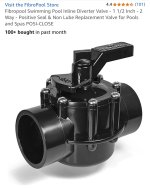I too am about to switch to a VS pump. My current 1hp motor is going out and a rebuild turned into seeing salt and corrosion inside so I talked my wife into a VS replacement.
Anyway I decided to use Ai to check some comparisons between cost and everything and was pretty impressed with the info it spit out so I thought I would mention that in case you want to see some more data with your specific setup.
Other than the first thing talking about the turn over importance I think the info was pretty good
Ai results:
With your pool at 19,000 gallons and the CircuPool RJ-45 Plus saltwater generator (SWG) paired with the Century VGreen 1.65 HP variable speed pump running 24/7 in Greenville, SC, with Laurens Electric, we can refine the lowest speed needed and the associated cost, factoring in your pool size and turnover needs alongside the SWG’s flow requirements.
### Step 1: CircuPool RJ-45 Plus Flow Requirements
The RJ-45 Plus requires:
- **Minimum flow rate**: 25 GPM to operate and avoid flow switch errors.
- **Maximum flow rate**: 105 GPM.
- Designed for pools up to 45,000 gallons, it’s well-suited for your 19,000-gallon pool.
The pump must deliver at least 25 GPM to keep the SWG running reliably.
### Step 2: Pool Turnover Considerations
For a 19,000-gallon pool, standard practice recommends 1–2 turnovers per day for cleanliness and chemical distribution:
- **1 turnover**: 19,000 gallons ÷ (1440 minutes/day) = ~13.2 GPM average.
- **2 turnovers**: 19,000 gallons × 2 ÷ 1440 = ~26.4 GPM average.
Running 24/7, the pump’s constant flow equals the average turnover rate. At 25 GPM (the SWG minimum), you’d get:
- 25 GPM × 1440 minutes = 36,000 gallons/day, or ~1.9 turnovers—perfectly adequate for a 19,000-gallon pool and aligning with the RJ-45 Plus’s needs.
### Step 3: VGreen 1.65 HP Pump Flow at Low Speeds
The VGreen 1.65 (e.g., ECM16SQU) ranges from 600 to 3450 RPM, and flow depends on RPM, your existing pump’s wet end, and total dynamic head (TDH). For a 19,000-gallon pool, assume typical plumbing (1.5”–2” pipes, 20–40 ft TDH). Flow estimates with a standard 1–1.5 HP pump housing (e.g., Hayward Super Pump or Pentair WhisperFlo):
- **3450 RPM**: ~60–80 GPM (say 70 GPM at moderate head).
- **1200 RPM**: ~20–25 GPM (35% of max flow).
- **1500 RPM**: ~25–35 GPM (43% of max flow).
To hit 25 GPM:
- **1200 RPM**: May deliver 25 GPM in a low-head system (e.g., 2” pipes, short runs, clean filter), but it’s near the edge.
- **1500 RPM**: More consistently provides 25–30 GPM, ensuring SWG operation and accounting for typical head loss.
Given your smaller pool size, TDH is likely moderate (not overly restrictive), so 1200 RPM could work, but 1500 RPM remains a safer bet for reliability.
### Step 4: Lowest Practical Speed
For the RJ-45 Plus’s 25 GPM minimum and your pool’s turnover:
- **1200 RPM**: Likely achieves ~25 GPM in your setup, meeting both SWG and turnover needs (~1.9 turnovers/day). This is the theoretical minimum if your plumbing is efficient.
- **1500 RPM**: Delivers ~28–30 GPM, exceeding the SWG minimum and providing ~2.2 turnovers/day, offering a buffer for filter backpressure or debris.
Since you’re running 24/7, 1200 RPM should suffice for your 19,000-gallon pool, but test it to confirm the SWG doesn’t trip.
### Step 5: Power Consumption and Cost
Using Laurens Electric’s 15.75 cents/kWh:
- **1200 RPM**: ~0.3 kW (300 watts).
- Energy = 0.3 kW × 24 hours = 7.2 kWh/day.
- Cost = 7.2 kWh × $0.1575 = **$1.13/day** or **$33.90/month** (30 days).
- **1500 RPM**: ~0.45 kW (450 watts).
- Energy = 0.45 kW × 24 hours = 10.8 kWh/day.
- Cost = 10.8 kWh × $0.1575 = **$1.70/day** or **$51/month**.
### Final Answer
For your 19,000-gallon pool with the VGreen 1.65 HP pump and CircuPool RJ-45 Plus running 24/7:
- **Lowest speed**: **1200 RPM** should work, delivering ~25 GPM, meeting the SWG’s 25 GPM minimum and providing ~1.9 turnovers/day. If the SWG indicates “low flow,” increase to **1500 RPM** (~28–30 GPM) for reliability.
- **Cost at 1200 RPM**: **$1.13/day** or **$33.90/month**.
- **Cost at 1500 RPM**: **$1.70/day** or **$51/month**.
### Recommendation
Start at 1200 RPM after installation. Monitor the RJ-45 Plus for flow errors and verify chlorine levels (aim for 1–3 ppm free chlorine). If needed, bump to 1300 or 1500 RPM. Your 19,000-gallon pool’s moderate size and the RJ-45 Plus’s capacity suggest 1200 RPM will likely be enough, keeping costs low at $33.90/month. Let me know how it performs once installed!







